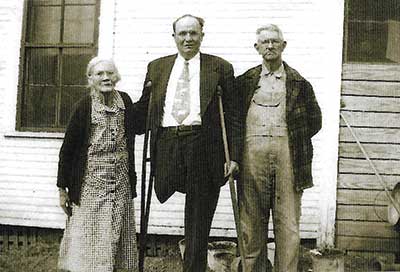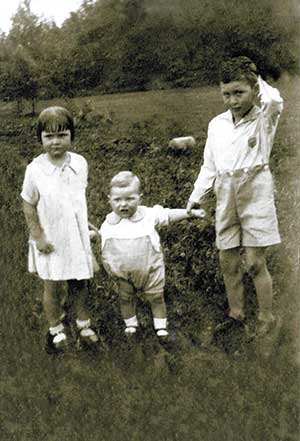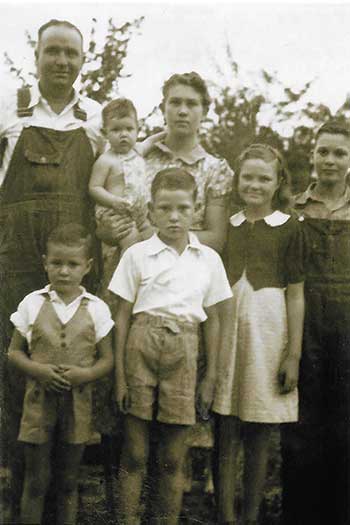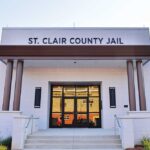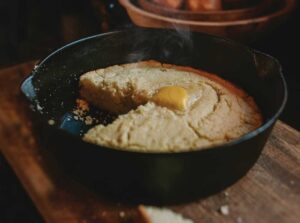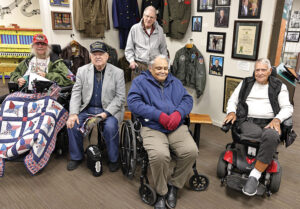
Meandering through time
Story by Joe Whitten
Submitted photos
Several lovely valleys run through St. Clair County and bear the name of the streams meandering through them: Coosa Valley, Cahaba Valley, Beaver Valley, and Shoal Creek Valley.
And then there’s Slasham Valley. Why name any place Slasham? A local fellow recently commented that he hoped it had nothing to do with slashing somebody. And it doesn’t.
The name’s origin rests in folklore passed down from the 19th Century. The story has been recorded in Mildred Wright’s book, Josiah W. Wilson and Lydia Melinda Wilson and Slasham Valley, St. Clair County, Alabama Kinfolk. “Tradition holds that in the early days of the settling of the valley, a house-raising was in progress. An Irishman with a heavy brogue stopped and offered to do work for a meal. After being served once, he said, ‘May I have another slosh o’ ham?’” Folk had fun mimicking his heavy Irish brogue in the retelling, and thus was the valley named.
When in the 19th century this occurred, we have no record. However, the earliest obituary mentioning Slasham Valley is found in Pell City Library’s online copy of By Murder, Accident, and Natural Causes. It reads: “Jun. 27, 1883, Southern Aegis: Died. Odom. On June 23, 1883, in Slasham community, this county, John Odom, about 22 years old.” The name no doubt predates this obituary by a number of years, for the north end of the valley consisted of enough families by 1830 to organize Hopewell Baptist Church.
Alsoin Josiah W. Wilson and Lydia Melinda Wilson and Slasham Valley, St. Clair County, Alabama Kinfolk, Mildred Wright gives the location of Slasham Valley, writing, “Slasham Valley lies east of the town of Ashville, between Canoe Creek Mountain and Beaver Creek Mountain. The primary watercourse is Permeter Creek. ‘Permeter’ is the colloquial name for palmetto (U.S. Government geological survey map, Steele quadrangle). Highway 33 runs the course of the valley.”
Lelias Kirby, born 1895, included the town of Steele in his sweeping description of the valley. His parents L. S. and Nannie Lee Spradley Kirby were married February 7, 1884, and settled in Slasham Valley near the Etowah County line above Hopewell Church on today’s Rainbow Drive. In the introduction to Lelias’ booklet, How Me and Amos Won WWI, Lou Harper states, “Although Slasham does not appear on any map of Alabama, Dr. Kirby claims it does exist somewhere in a circle taking in… Steele and Ashville.” In the book, Lelias writes that the community was “…located between Greasy Cove and Smoke Neck. …It was 10 miles to the nearest little village, Ashville.” Smoke Neck seems too expansive because it was in Etowah County. Today Smoke Neck is Southside, Alabama.
Today, Slasham Road begins in Ashville at 10th Street and Greensport Road and runs from there to County Road 33 near Gum Springs Baptist Church. It is a peaceful valley of farms and homes.
Stewart and Nannie Kirby’s family consisted of daughters: Elsie, May, Geneva, and Anna; sons: Joe, Amos, Lelias, Otis and Taylor.
Lelias became a well-known physician in Birmingham and authored 3 booklets: How Me and Amos Won WWI, Corncobs, Cockleburs and Country Boys, and Cotton Picking’ Coon Huntin’ Country Boys. Otis became a Methodist Minister, serving in the North Alabama Conference for many years. He authored It All Started in Slash-Ham. In these books, the Kirbys recorded their growing up in Slasham, St. Clair County Alabama.
In How Me and Amos Won WWI, Lilias told how the family “…walked two miles to Mount Hope Methodist,” and said, “I could see the lizards playing races across the rafters.” He told how their pastor, J. M. Wigley was encouraged as he preached his long sermons “…by a chorus of ‘Amens!’ from the ‘Amen Corner.’”
J. M. Wigley, a college student, lived in Steele and “…walked five miles through the flat woods” once a month to preach at Mount Hope. This was November 1913, and “…the log road was very muddy, but he arrived on time—11:00 A.M.”
Lelias recalled a non-religious family in Slasham that “never attended church.” However, at Bro. Wigley’s encouragement, the whole family attended a service. Two of the younger boys went to sleep on a pallet with other children. The Methodist in the South in those days were called “Shouting Methodist.” This was not “speaking in tongues,” but understandable shouts of praise to God. Therefore, as the service and preaching progressed, the saints of the Lord began rejoicing by shouting “Hallelujah!” “Praise the Lord!” “Glory to God!” As these praises reverberated from wall-to-wall, one of the boys awoke, grabbed his brother and said, “Quick, let’s head to the barn; Ma and Pa are fighting a-gin.”
In his section on church life, Otis Kirby, in It All Started in Slash-Ham, writes “Mt. Hope [Methodist] Church was a large, unpainted frame building. I remember sitting on rough-hewn benches and reading my little Olivet picture card… The church stood on the banks of Big Canoe Creek in the northeastern corner of St. Clair County where Auberry Bridge spanned the creek.”
In her History of Steele, Alabama, Vivian Qualls records that “Bro. Wigley” was J. M. Wigley who pastored the Steele Circuit in 1913 and 1914. And in History of Methodism in Alabama and West Florida by Marion Elias Lazenby, Rev. James Milton Wigley is mentioned six times. The last reference is in 1929 when the Methodist Conference appointed him “Financial Agent” to Athens College.
The Kirby children attended Ford Schoolhouse. As related by Otis in It All Started in Slash-Ham, the school was named after “Uncle John and Aunt Jeff” Ford because they lived close to the school and “the teacher always boarded with them.” Constructed of boards, the school had one unpainted room. The teacher’s desk sat on a raised section that ran the width of the room. Being on the stage gave the teacher “…better oversight of the student body and indicated who was boss.”
“The water bucket,” Otis continued, “was placed on a shelf on the wall outside the front door. Everybody drank from the same dipper. We ‘toted’ water from the wet-weather spring down in Uncle John’s pasture.”
According to both the Kirby brothers’ memories, one end of the Ford Schoolhouse rested on the ground while the other end stood about three feet off the ground and was partially underpinned. Otis related that “…on rainy days goats and hogs would move out of the flatwoods and shelter themselves under the schoolhouse.” The animal noises sometimes drowned out the human voices. There were cracks and holes in the floor, and Otis recalled one winter when his brother “Amos quite accidentally (?) let a few red-hot coals drop through the holes onto the backs of the hogs.” This caused a pandemonium of grunts and squeals as the hogs fled the shelter and headed to the woods—for a few days.
In the April 1997 issue of Cherish: The Quarterly Journal of the St. Clair Historical Society, Ada Wilson Sulser (b1897-d1988) wrote memories titled “Zion Hill Schoolhouse.” She attended there beginning in 1903 and recalled that the school located next to Zion Hill Church held “…classes from November to April, weather permitting.” She also mentioned classmates: “Homer Waldrop , Clem Lowery, Claudie Wilson , Dora Putman, Houston Cobb, Clara Wilson, Wakely Wilson and Vivian Palmer.”
“The schoolhouse burned twice,” she recalled and added, “It was a standing joke that when a member of a certain family was expelled, the schoolhouse would burn.
Curtis and Lurla Fail Franklin set up housekeeping in Slasham Valley around 1925. In time the family grew to include five children: Hubert, Margaret, J. C., and Billy. All three boys became Church of God ministers and evangelists. Billy Franklin’s son is Jentezen Franklin, internationally known evangelist and pastor of a mega-church in Gainesville, Georgia. In 2008 his book Fasting was on the New York Times Best Seller list.
Today, 95-year-old Margaret Franklin Berry cherishes memories of living in Slasham Valley and attending Ashville elementary school. Her best friend at school was Betty Jean Hodges. “The family lived right in the middle of Ashville,” she recalled. “In fact, the first time I ever saw an electric refrigerator was at their house. She and I were in school together, and I went home with her for lunch one day. Her mother had frozen some little popsicles for us. I’ll never forget that.”
After the third grade, the family moved to Birmingham. Margaret’s father, John Curtis Franklin, had a job in Avondale. “He was a paint sprayer. And that’s when they used lead in the paint,” she told the interviewer. “Well, daddy got really sick. He had ‘paint poison,’ and ended up having to have his leg amputated. It was a terrible time. He was crippled and walked on crutches the rest of his life after the amputation. So, we moved back and forth from the farm to Birmingham several times.”
It was the Great Depression years, and the Franklin family would live in Birmingham for a while and then back to Slasham for a while during those Depression years.
“When we first moved back from Birmingham to Slasham,” Margaret reminisced, “the farm had been leased out to a sharecropper, and we couldn’t move into that house that daddy owned. So, we rented a house. We had no electricity in the area at that time, and I am positive they had no running water. Everybody had wells. But there was a spring on the place that daddy rented, and that’s where we kept our milk to keep it cold. I guess the milk was ice cold, for the spring water certainly was. Every night for dinner, mother would send me and my brother Hubert down there to get the milk out of the spring.”
Although it was hard times during the depression, Margaret recalled that Pawpa J. G. Baswell, her step-grandfather, “…had six sons and they all had houses all down Slasham… All you had to do was to let somebody know you needed help and help was there.” She thought a moment, then spoke of God’s goodness. “I can hardly ever think about all those years and what we went through, without knowing that we were so blessed, and that God took care of us. All of us.”
After commenting, “I’ve not thought of some of this in years,” Margaret recounted things she and Hubert enjoyed as children.
“On one of our returns to Slasham, we lived in an old house that had a porch, and when they picked cotton, they made one end of the porch, the cotton spot. I don’t remember how they enclosed it, but they would just pile that cotton up there, on and on and on until the day they took it to the cotton gin. Hubert and I used to play in that cotton. We’d jump around in it just like kids today jump on a trampoline. That was so much fun!”
Then another memory came to mind. “When we needed cornmeal, they would send Hubert and me out to the corn crib to shell corn. I remember gallon buckets of shelled corn, and I’d go with my daddy when he’d take it to the mill to have it ground. It was so fascinating to watch that miller pour the corn into that hopper, and it come out cornmeal.” She couldn’t remember the name of the grist mill her dad used.
A community event Margaret recalled was Box Suppers. In the 1930s and ‘40s, schools and churches would raise money by sponsoring “Box Suppers.” Girls would prepare a picnic lunch to place in a decorated box for this community event where the “box suppers” were auctioned, with the money going to the sponsoring school or church. These events were announced in the papers as seen in the Southern Aegis of January 29, 1920. “Box Supper at Zion Hill Saturday night Jan. 31st. Bring boxes and have a good time.”
Margaret remembered participating as a young girl. “You would just spend days and days decorating a beautiful box with ribbons and all kinds of decorations. And you’d think up something really enticing that you hoped would tempt the guys, you know. And they would bid on the box, and whoever bought it was who you ate with. Of course, you hoped that one of the guys you liked would be the one who bid on it! I must have had a sweetheart who I was wanting to bid on it.”
Margaret’s family attended Gum Springs Baptist Church in the old building and in the current building. The first sanctuary was across the street from today’s Gum Springs and located near the cemetery on that side of the road. There seems to be no photo of that first building.
An annual special occasion was “Decoration Day” (Memorial Day) each year on Mothers’ Day at Gum Springs. In olden days, the week before Mothers’ Day, community folk would clean the cemetery so graves would look nice for flower decorations on Sunday. On that Sunday, folk recalled old memories, enjoyed good preaching, joyful singing, and “dinner on the ground” after morning service. In truth, this event was a community reunion.
All day singings and singing schools occurred at Gum Springs Baptist and at Zion Hill Methodist. Margaret recalled them, saying, “They had Sacred Harp singing at Gum Springs. And they had special people come who taught us.” They called those events “singing schools.” Sacred Harp singing had no musical instruments, for the voice was the “sacred harp.”
County newspapers announced these singing Sundays, as in this September 28, 1922, issue of the Southern Aegis “Slasham News” column: “There will be a singing next Sunday at Zion Hill. Everyone come and bring your books.” Sacred Harp singers used special books which used fa sol la musical notations.
All Day Singings was another type musical event. They were also announced in the Southern Aegis, as in this October 17, 1917 issue. “All Day Singing at Gum Springs. Joe Baswell will sing at Gum Springs the third Sunday in this month, beginning about nine o’clock a.m. and sing all day. Everybody have [sic] an invitation to go and especially the singers, and still more especially those who will carry DINNER out for we may go, and if we do, it will take a lot of it, you bet.” You can’t have an “All Day Singing” without “Dinner on the Ground.” These were social as well as spiritual events.
Bo Davis, a 5th generation Davis living on the Slasham Valley Davis Farm, recounted interesting information in a recent interview.
The original Davis house burned and Bo’s great granddad, James Davis, rebuilt it. It still stands today on Davis Drive. “My Granddaddy, Robert Ely Davis, was born in 1878,” Bo said, “and the house burnt when he was two weeks old. His sister grabbed him up, pillow, mattress, and all, and carried him to the smokehouse.” Later, when the excitement of the fire came to an end, Jim asked, “Where’s the baby?” “He’s out there in the smokehouse,” they told him. And there they found him, sound asleep.
From the burned home, “They saved some of the sills and used them when they rebuilt the house,” Bo told the interviewer. “In that old house—my granddaddy’s house—the lumber on the walls are boards 25 inches wide. That lumber was sawed in 1878 when they built the house. They had a sawmill, and they sawed the planks and built the house back around the chimney of the old house.”
Bo was born in this house on December 21, 1943, and the valley was blanketed in ten inches of snow.
After Zion Hill Methodist Church burned, the Methodist Conference decided not to rebuild and all that remained was the cemetery. However, Bo remembered two preachers who came and held revivals on Zion Hill property.
One evangelist held services under a “brush arbor.” An online article, “The history of Brush Arbors,” gives this description: “Rural folk built a brush arbor by putting poles in the ground for the sides and then poles across these uprights. For the roof covering, they cut bushes and branches and laid them across the roof poles for a covering.”
Bo recalled that a “Rev. A. E. Jones would come from Gadsden and hold a week or two brush arbor revival on Zion Hill. He’d come down to my grandmother and get permission to run power lines down to my grandaddy’s house so they could have lights at night.”
“There was another preacher who ran a tent revival,” Bo recollected. “I think his last name was Bowlen who lived down around Margaret. He had tent revivals there back in the ‘50s.”
Slasham Valley has been a place called home for almost 200 years now. Settled year-by-year by families relocating from other states, it became a sweeping valley of farms and homes, schools and churches, and cemeteries, for with living comes dying. Folk who live, or have lived, in the valley speak of it with affection and love, and for all of those who have called it home, the lyrics of a song as old as Slasham hums in their hearts:
Mid pleasures and palaces, though we may roam,
Be it ever so humble, there’s no place like home.
Home, home sweet home
There’s no place like home.














